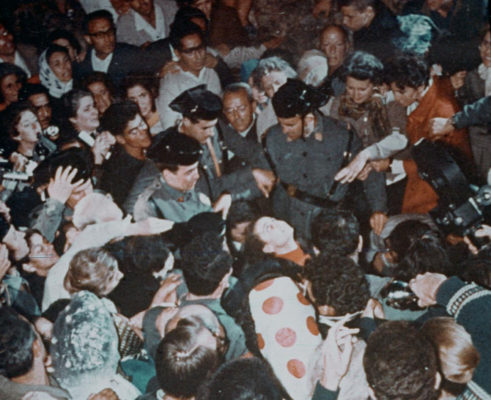Search
To search for an exact match, type the word or phrase you want in quotation marks.
A*DESK has been offering since 2002 contents about criticism and contemporary art. A*DESK has become consolidated thanks to all those who have believed in the project, all those who have followed us, debating, participating and collaborating. Many people have collaborated with A*DESK, and continue to do so. Their efforts, knowledge and belief in the project are what make it grow internationally. At A*DESK we have also generated work for over one hundred professionals in culture, from small collaborations with reviews and classes, to more prolonged and intense collaborations.
At A*DESK we believe in the need for free and universal access to culture and knowledge. We want to carry on being independent, remaining open to more ideas and opinions. If you believe in A*DESK, we need your backing to be able to continue. You can now participate in the project by supporting it. You can choose how much you want to contribute to the project.
You can decide how much you want to bring to the project.

On Sunday I went to my mother’s house for supper. As it’s a tradition in my family to eat supper on a Sunday with a film, I ended up looking on the shelves of old DVD’s for a film to end the weekend in peace and tranquillity. The candidate that evening was “La Dolce Vita” by Fellini, ‘a film that you can always watch again’. And we watched it again and ended the week peacefully.
To begin another week I decided to go up to the Fundació Miró to take a look at the Espai 13, and remembered the film I’d seen last Sunday night. I just couldn’t look at the exhibition by Julia Montilla without thinking about that scene when the children watch the Virgin appear. In reality the scene isn’t about children and apparitions of the Virgin Mary, so much as the construction of the media and the deployment of techniques and technicians to construct such an event. Equally, “El ‘cuadro’ de la ‘calleja’” (La Calleja’s «Fenced Square») by Julia Montilla doesn’t exactly deal with the phenomenon of the Virgin’s repeated visits to the town of Garabandal in the sixties, so much as the visual representation of a phenomenon, of how it is represented and how such a representation is constructed.
The scene of “La Dolce Vita” is a master class in a certain type of journalism; we see crowds running to the ‘scene of the events’, and later we see ‘real’ witnesses give an account of the events, narrated specially for the journalists and afterwards they pose for the photographers. Then we see how they set up structures for the spotlights and the cameras so that they can film during the night and later security sets up a security cordon. At the end a girl and a boy appear, running from one side to another, pointing, they kneel down and people cry and the conductor directs the orchestra.
Step one: Federico Fellini explains how the media constructs an event.
Step two: Julia Montilla investigates the forms of such a construction.
More or less.
With the classic tools of a visual ethnographic study, the artist analyses, through archive images, the media phenomenon of the girl seers that occurred, in the sixties, in a small town in the depths of Cantabria. The apparitions and their messengers is a particularly curious subject to analyse, as the images don’t pretend (in the case of the proposal at the Miró, other cases of research by the same artist do) to show the apparition of the Saint or the Virgin in question, so much as the ecstatic bodies of the mediums. That is they don’t represent the nucleus of the phenomenon – the apparition – so much as the means by which the phenomenon is transmitted and represented, one could say that such a phenomenon is practically un-representable. From the large quantity of photographs produced and distributed across the world, the artist makes an analysis of the bodies and languages that represent ecstasy, placing them in relation to the texts that accompany them, the picture caption, the stories…
The artist isn’t interested in the spiritual aspect, so much as making manifest what is shown and what is hidden, how once again the construction of a phenomenon is subject to its representation, and how this representation responds to a context. Julia Montilla suggests that this type of phenomenon manifests itself in a more exaggerated fashion in coincidence with the more progressive periods of Spanish history. Implying that in the periods when the Church has felt its influence is threatened in relation to other powers, in certain places the flame of veneration has been fuelled with this type of event.
There are other examples of this form of analysis in art today. The project ‘El Mundo de los vencedores’ that Ignasi Prat presented at the Sala d’Art Jove in 2012, is a representation of the power of Francoism that is constructed out of the images of mansions occupied by some of the military officials during the regime. Ignasi Prat reconstructs the histories up to the present day, tracking down official documents such as death certificates (documents that are also on the web), and locating the mansions and their situation today, creating in turn an important archive of images and documents that don’t leave one indifferent.
Both artists approach the subject of representation and the analysis of these images in relation to the context in which they were created, aspects that are highly pertinent in the hyper-imagined world of today where learning to read images is fundamental to understand not just what surrounds us, but also how it is constructed.
The exhibition of Julia Montilla at the Espai 13 in the Fundació Miró “El ‘cuadro’ de la ‘calleja’” forms part of the exhibition series ‘Perplexitat’ curated by David Armengol, and can be seen until 21 April. The publication produced as a result of this project will be presented tomorrow (11 April) at 7.30pm.

Caterina Almirall has only just been born into this world, but has lived in others, in similar parallel worlds, both liquid and solid. From each she has learnt something, and forgotten something else. Learning to unlearn. In all of these worlds she has been caught up in a web that interweaves everything, some call it ’art’…Entwining, unravelling, weaving and destroying this labyrinth has been her occupation in each one of these planets, and she fears that it will be the same in each of the ones to come.
"A desk is a dangerous place from which to watch the world" (John Le Carré)